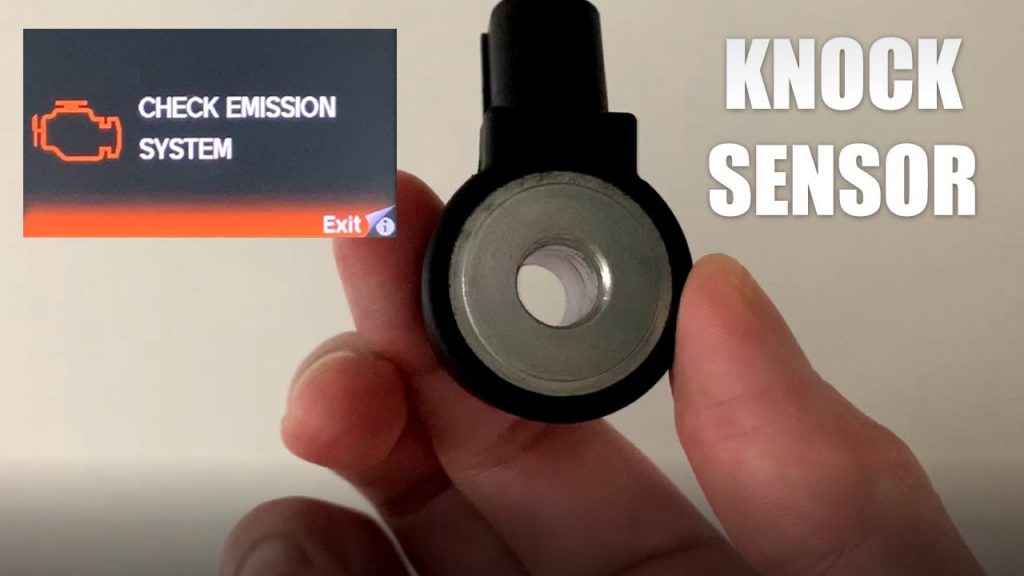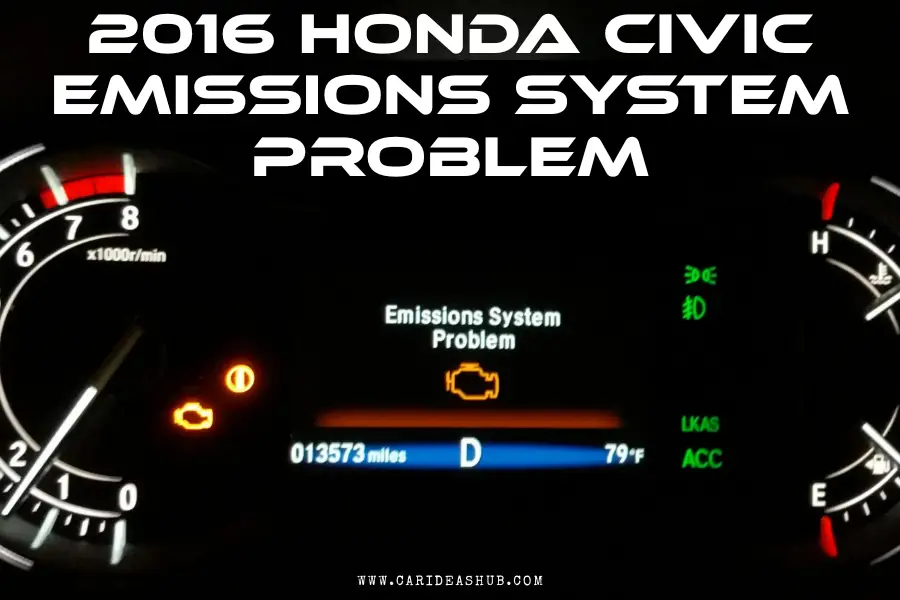The 2016 Honda Civic may display an emissions system problem due to a faulty oxygen sensor or software issues. It’s crucial to diagnose and address this promptly to prevent potential damage.
Owners of the 2016 Honda Civic occasionally encounter warning messages regarding the vehicle’s emissions system. These problems often stem from components such as the oxygen sensor, fuel injectors, or catalytic converter. Regular maintenance helps mitigate such issues, but sometimes the appearance of an emissions warning indicates a need for immediate professional attention.
Timely diagnostics can avert more severe engine problems and ensure adherence to environmental regulations. Honda has acknowledged some of these concerns through service bulletins and warranty extensions, making it essential for owners to stay informed about potential recalls or service campaigns related to the emissions system. Addressing these problems quickly maintains not only the car’s performance but also its resale value and compliance with emissions standards.

Credit: carfromjapan.com
Common Indicators And Symptoms
If you own a 2016 Honda Civic, it’s crucial to remain vigilant for signs of emissions system issues. Over time, the complexity of a vehicle’s emissions system can lead to various problems, but there are a few common indicators that can alert you early. Recognizing these symptoms not only helps in maintaining your vehicle’s health but also ensures that it continues to conform with environmental regulations. Let’s discuss these key indicators and what they could mean for your Honda Civic.Illuminated Check Engine Light
Illuminated Check Engine Light
One of the most obvious signs that there could be an issue with your emissions system is the check engine light. This light is part of your Civic’s onboard diagnostics system, and when it lights up, it indicates that the computer has detected an anomaly in the vehicle’s operations.Reduced Fuel Efficiency
Reduced Fuel Efficiency
Another common symptom is a noticeable drop in fuel efficiency. If your 2016 Civic isn’t going as far on a tank of gas as it used to, it might be due to a fault within the emissions system. This could range from issues with the oxygen sensors to the catalytic converter — both integral to efficient engine performance.Noticeable Exhaust Smell
Noticeable Exhaust Smell
Lastly, an unusual smell coming from the exhaust can be a telltale sign of emissions problems. If you’re catching whiffs of a sulfur or rotten egg-like scent, this could indicate a malfunctioning catalytic converter, which is responsible for controlling and converting exhaust emissions.
Staying informed and proactive with these symptoms helps ensure your 2016 Honda Civic runs smoothly and remains eco-friendly. Regular check-ups are recommended to catch any issues early and to prevent any potential emissions system fault from escalating.
Quick Fixes For Emissions Failures
If your 2016 Honda Civic is facing emissions system problems, resulting in a failed emissions test or a triggered check-engine light, consider these quick and straightforward fixes before heading to the mechanic. Even seemingly minor details can affect your car’s emissions. Let’s go through some of the quick fixes that might just turn off that pesky check-engine light and clear the way for a pass on your next emissions test.Tightening gas cap
Tightening Gas Cap
A loose gas cap is a common, yet often overlooked cause of emission system problems. Ensure the gas cap on your 2016 Honda Civic is properly tightened; a cap that isn’t sealed correctly can trigger the check-engine light. After tightening, it may take a short drive cycle for the light to turn off. If the cap is damaged or worn, consider replacing it with an OEM part to maintain the integrity of your fuel system.Using fuel additives
Using Fuel Additives
Over time, engines develop buildup which can hamper performance and affect emissions. Using fuel additives can clean out these deposits and restore engine function. Look for additives that are specifically designed to reduce emissions; they often have the added benefit of improving fuel economy. Be sure to follow the manufacturer’s instructions when adding them to your fuel tank.Replacing air filters
Replacing Air Filters
A dirty air filter can exacerbate emissions problems by restricting airflow, thereby altering the air-fuel mixture. Installing a new, clean air filter not only helps with emissions but can also improve your car’s performance and gas mileage. Air filters should be checked regularly and typically replaced every 12,000 to 15,000 miles or as recommended in your Honda Civic’s owner manual.
Troubleshooting With Obd-ii Codes
The 2016 Honda Civic is a reliable and popular vehicle, but like any car, it can experience issues with its emissions system. These problems can trigger dashboard warning lights and negatively affect performance. ‘Troubleshooting with OBD-II Codes’ is an efficient approach to identify and rectify these issues. The On-Board Diagnostics II (OBD-II) system monitors various vehicle functions, especially emissions. When it detects a problem, it saves a corresponding diagnostic trouble code (DTC) that can help reveal the root cause of the issue. Learning to use an OBD-II scanner and interpret its codes is a crucial step in diagnosing and fixing emissions-related problems.
Reading Error Codes With An Obd-ii Scanner
Begin troubleshooting the emissions system by connecting an OBD-II scanner to your Honda Civic. This device can read, record, and sometimes even interpret error codes that your vehicle’s computer has stored. Here is how to use it:
- Locate the OBD-II port: Usually found under the dashboard, near the steering column.
- Connect the scanner: Plug in the scanner while the car is off. Then, turn the ignition to the “On” position so the dashboard lights are on, but the engine is off.
- Retrieve the codes: Follow the scanner’s prompts to read the DTCs. Some scanners offer additional data that may be helpful for advanced troubleshooting.
- Record the codes: Make a note of all the retrieved error codes to investigate their meaning and potential fixes.
Interpreting Common Emission-related Codes
Once you have the DTCs, deciphering them is the next step. Common emission-related OBD-II codes for the 2016 Honda Civic include:
| Code | Description | Possible Causes |
|---|---|---|
| P0420 | Catalyst System Efficiency Below Threshold (Bank 1) | Faulty catalytic converterOxygen sensors malfunctionExhaust leak |
| P0171 | System Too Lean (Bank 1) | Vacuum leaksFuel delivery issuesClogged fuel injectors |
| P0300 | Random/Multiple Cylinder Misfire Detected | Ignition system faultsFuel system problemsInternal engine issues |
| P0138 | Oxygen Sensor Circuit High Voltage (Bank 1, Sensor 2) | Faulty oxygen sensorWiring problemCircuit issues |
Analyzing these codes and the symptoms associated with them can help pinpoint the malfunction within the emissions system. These DTCs, however, are general guidelines and further diagnostics may be required to isolate the exact problem. It is crucial to address emission system errors promptly as they can lead to performance issues and even impact the Civic’s fuel efficiency and environmental output.
Step-by-step Sensor Replacement Guide
Welcome to our ‘Step-by-Step Sensor Replacement Guide’, designed specifically for those experiencing emissions system problems with their 2016 Honda Civic. Emissions issues can manifest due to faulty sensors, and two critical components often responsible are the oxygen (O2) sensors. In this guide, we’ll walk you through the process of identifying malfunctioning sensors and how to replace them on your own, potentially saving time and money.Identifying malfunctioning O2 sensors
Identifying Malfunctioning O2 Sensors
Detecting a faulty O2 sensor in your vehicle is the first crucial step towards clearing that dreaded check engine light and improving your car’s performance. Symptoms of a bad sensor can include reduced fuel economy, a rough idle, or an unexpected surge in emissions. To confirm the health of your O2 sensors, you’ll need:
- A diagnostic scanning tool
- The vehicle’s service manual
Connect the scanner to your Civic’s onboard diagnostics port (OBD-II), usually located under the dashboard. Run the scanner to retrieve any fault codes, and cross-reference these with your service manual to pinpoint if an O2 sensor is the culprit.DIY replacement of emissions sensors
Diy Replacement Of Emissions Sensors
Replacing an emissions sensor can seem daunting, but with the right tools and a bit of patience, it’s a task you can tackle in your own garage. You will need:
- A replacement O2 sensor
- A socket wrench set, including an O2 sensor socket
- A jack and jack stands or ramps
- Possibly penetrating oil for rusted components
Before you begin the replacement, please ensure the vehicle is cool and parked on a level surface. Place the vehicle on jack stands or ramps for safety.
Follow these steps to replace your Honda Civic’s O2 sensor:
- Locate the sensor: Refer to the service manual for the precise location of the O2 sensors.
- Remove the electrical connector: Gently detach the connector linked to the O2 sensor.
- Unscrew the faulty sensor: Using the O2 sensor socket and wrench, carefully unscrew the malfunctioning sensor.
- Compare sensors: Verify that your new sensor is identical to the old one.
- Install the new sensor: Carefully thread the new O2 sensor by hand to avoid cross-threading, and then tighten it securely with the socket wrench.
- Reconnect the electrical connector: Ensure it snaps into place for a proper connection.
- Test the replacement: Start the vehicle to ensure the replacement was successful and the check engine light no longer illuminates.
Remember: Always double-check your work for accuracy and safety. If the check engine light persists after replacing the sensors, seek professional assistance to diagnose further issues.
When To Seek Expert Honda Repairs
The iconic 2016 Honda Civic stands as a paragon of reliability, but even the best-engineered vehicles can encounter issues, particularly with complex systems like emissions control. For Civic owners experiencing potential emissions system problems, it’s crucial to identify when professional assistance is required. Recognizing the right time to seek expert Honda repairs ensures the longevity of your vehicle, adherence to environmental standards, and maintenance of optimal performance. Below, we’ll explore how to recognize intricate emissions system challenges and find certified technicians equipped to handle your Civic’s needs, all the while keeping your car running smoothly and eco-friendly.
Recognizing Complex Emission System Issues
Understanding the signs of emissions system complications can save you time and money. It’s essential to be vigilant about:
- Check Engine Light: When this light illuminates on the dashboard, it’s signaling a potential problem, which could be emissions-related.
- Decreased Fuel Efficiency: A drop in miles per gallon can indicate that the emissions system isn’t functioning correctly.
- Unusual Noises or Smells: These can be telltale signs of a malfunction that warrants immediate attention by a professional.
Expert intervention becomes imperative if your Civic fails an emissions test or you notice any of these symptoms persisting. Because the emissions system is integrated with various sensors and components, diagnosing issues accurately requires advanced tools and expertise.
Finding Certified Honda Repair Services
Once you’ve identified the need for repairs, it’s time to locate a certified Honda service provider. Here’s how to ensure you choose a qualified expert:
- Look for Certification: Seek out technicians with ASE (Automotive Service Excellence) certification or those certified directly by Honda.
- Dealer vs. Independent: Consider whether a Honda dealership or an independent repair shop will best meet your needs. Dealerships usually possess specialized tools and in-depth knowledge of Honda vehicles.
- Read Reviews: Online reviews and testimonials can provide insights into the quality of service and customer satisfaction.
- Ask for References: A reputable service provider should be willing to share references from previous clients with similar repair needs.
Choosing the right repair shop is pivotal for correctly handling your Civic’s emissions system issues, ultimately ensuring that your vehicle complies with environmental regulations and operates at peak efficiency.
Frequently Asked Questions For 2016 Honda Civic Emissions System Problem
What Causes Emissions System Issues In A Honda Civic?
Emissions system problems in the 2016 Honda Civic commonly stem from a faulty oxygen sensor or catalytic converter. These components are crucial for controlling exhaust emissions and ensuring efficient engine operation.
How Do I Fix A Honda Civic Emission Error?
To fix a Honda Civic emission error, first diagnose the issue with an OBD-II scanner. Depending on the code, you may need to replace the oxygen sensor, catalytic converter, or fuel cap, amongst other components.
Can A Faulty Egr Valve Trigger Civic Emissions Problems?
Yes, a faulty Exhaust Gas Recirculation (EGR) valve can lead to emissions issues in a Honda Civic. The EGR valve helps reduce nitrogen oxide, and if it malfunctions, it can disrupt the emissions system.
What Are Common Signs Of A 2016 Civic Emissions System Failure?
Signs include the Check Engine Light turning on, reduced fuel efficiency, and the car stalling or running rough. These symptoms indicate that the emissions control system may need attention.
Conclusion
As we’ve explored, the 2016 Honda Civic has a known issue with its emissions system. Owners must stay vigilant for signs of failure and seek timely repairs. Proper maintenance can prevent costly problems down the road. Keep your Civic running smoothly by addressing any emissions concerns immediately.
Drive green, drive smart.

